Dental Implants
A Dental Implant is an artificial tooth root that goes into your jaw to hold a replacement tooth or bridge.
Dental Implants are man-made replacements for natural teeth. Whether you have one missing tooth or no teeth at all, Dental Implants are the standard of care for tooth replacement in most situations. For years, the best solutions for missing teeth were bridges, removable partial or full dentures.
The implants are made from titanium, one of the same metals that hip and other joint replacements are made from. When we talk about Dental Implants we are really talking about two parts, the implant portion that looks like a screw or plate that replaces the root portion of the tooth in the bone and the crown portion that replaces the visible portion of the tooth in your mouth.
Implants can be used effectively if you are missing one tooth or even if you have no teeth at all. Dental Implants are today’s solution to missing teeth. Our life expectancy has increased along with our expectations for our oral health.
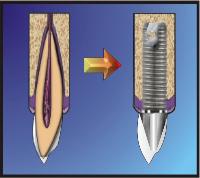
As teeth are lost it becomes more difficult, over time, to eat and chew food. You may be surprised to learn that many denture wearers eat only soft or mashed foods and many avoid many foods altogether. Partial or even full dentures were the solution for a long time, but unfortunately a solution with limitations. For many people they never felt like natural teeth and still limited us in terms of foods, comfort and esthetics. Dental Implants can now even be used to stablize and anchor partial or complete dentures !

Here is another of our patients. This gentleman had a few teeth left and was wearing a poorly fitting partial denture that was loose and embarassing because it would move and fall out whenever he spoke or ate. This man suffered from a loss of confidence both personally and in the company of others.He was wearing an old partial denture that didnt even fit properly anymore. He asked us what we could do to fix his “teeth” in his mouth so he could get back the confidence of his smile and chew ALL FOODS without a loss of function. We suggested implants and a retentive bar to lock down his new “teeth”. He says we changed his life but we think the before and after pictures tell the story- take a look:



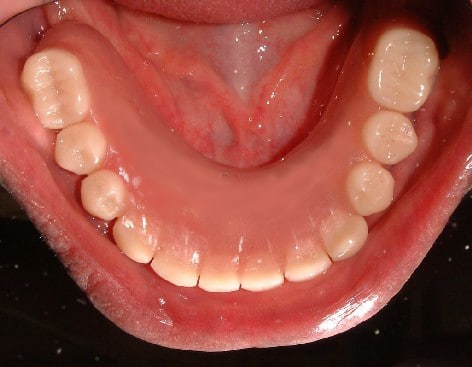
Implants restore proper chewing function and so you can enjoy foods previously too “difficult” to eat. You feel confident that your replacement teeth won’t move or loosen. You regain the closest thing to the look, feel and function of your natural teeth, and that’s a fact. Dental Implants are clinically proven with a high success rate.
Clearly Dental Implants are one of the finest treatment options dentistry has to offer. With their ability to improve the quality of your life and health it’s easy to understand why they have become the accepted alternative to traditional methods of replacing missing teeth.
The typical steps for the processes are:
Arrange an appointment to consult with Dr. Lehri. (Treatment options vary individually depending on bone structure and other conditions.) Together, it will be decided if you are a good candidate for Dental Implants. Dr Lehri will take a complete medical and dental history, x-rays and complete a thorough oral examination. In some cases CT scans, impressions, lab tests or other preliminaries may be required. If you are a suitable candidate for implant surgery, the procedure is as follows
1. Surgical placement of the implant(s) into the bone. This is usually done right in our office, with a local anaesthetic or a combination of local anaesthetic and gas. After surgery, there is a healing period of approximately 3 to 4 months. During this time, the implants fuse to the bone by a process known as ‘osseointegration’.

2. Next, there is a minor surgical exposure of the top of the implant, whereby Dr. Lehri will attach a “post” to the implant. The function of the “post” is to become the support for either one tooth or a set of teeth. This is a short procedure that usually requires only a local anaesthetic.
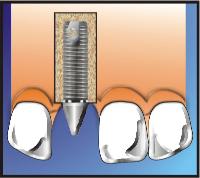
3. The last phase is the restorative phase. The Dr Lehri will take impressions and then make the tooth portion (crown(s)) that will attach to the implants. This will require several visits. Once completed, your mouth will be restored to natural looking fully functional teeth.
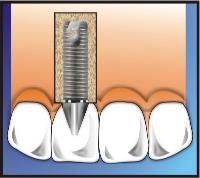
Here’s another of our patients. She has some old metal bridgework done a long time ago that was failing. She didnt want to loose her teeth and asked us to help her. We suggested implants and crowns. She cried with tears of joy when her treatment was complete and tells us she has never been able to chew as well as she does now. Here are the before and after pictures.

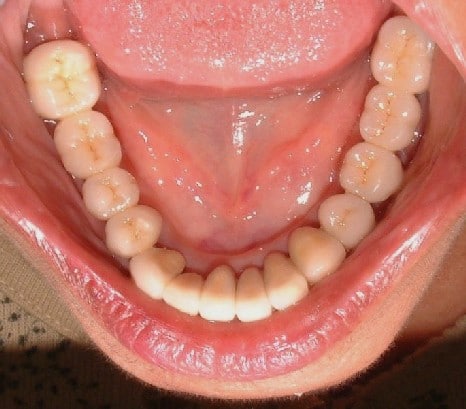
This is the stage when bone destruction may get involved. Eventually, the bone and gum structure supporting the teeth may be destroyed so extensively, that there is no remaining support for the teeth.
If plaque and tartar are not cleaned away, even gentle brushing can cause your gums to bleed. This is a sign of Gingivitis. Gingivitis is the mildest form of periodontal disease. It causes the gums to become red, swollen, and bleed easily. There is usually little or no discomfort at this stage. Gingivitis is reversible with professional treatment and good at home oral care.
The more severe form of gum disease is called Periodontitis. With this form of gum disease, the gums begin to pull away from your teeth. Pockets form between your teeth and gums. These fill with germs and pus and deepen. When this happens, you may need gum surgery or “deep” cleaning to save your teeth. If nothing is done, the infection goes on to destroy the bone around your teeth. The teeth may start to move or get loose. If we cannot thoroughly debride the area and irreversible loss of supporting structures has taken place, your teeth may need to be removed to save whatever bone is left and to minimize further damage to supporting structures.
Why is it important to replace a missing tooth?
It may not seem all that important when a single tooth is lost, yet over the long run it can have significant consequences. Missing teeth can affect both a person’s health & their ability to speak and chew. Their facial appearance may also be affected, as can their sense of self-confidence.
Losing just one tooth over an extended period of time may lead to a domino effect. More teeth will eventually be lost leading to a more severe the situation.If tooth and bone loss does occur we can consider replacing the missing teeth with dental implants or bone grafting after the stabilization phase.
Consider the following:
1. Loss of chewing ability – Lose enough teeth and your chewing capacity will be noticeably compromised. Cheeks may appear shrunken and bone loss begins to occur in your jaw because the lost tooth no longer stimulates the area of the missing tooth.
2. Remaining teeth are compromised – Teeth need each other for support. When your tooth is lost, the remaining teeth must work that much harder to carry the load. This increases the wear and tear on your remaining teeth and they may drift, tilt, collapse the bite, fracture or break.
Your adjacent and opposing teeth can gradually collapse into the empty space created by that missing tooth. After shifting, the long-term stability of the adjacent teeth is diminished. Most patients cannot tell this is happening. This misalignment can further compromise chewing function and significantly increasing your susceptibility to further tooth decay and gum disease.
As you can see, losing a single tooth can have a gradual domino effect on the remaining teeth – causing them to eventually fall as well.
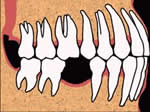
Loss of a single tooth
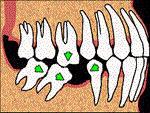
Shifting teeth

More decay and
gum disease
3. Bite and facial collapse – Your back teeth support the bite. Over time, your back teeth wear down. With missing teeth, support for the bite is lost and the remaining teeth tend to wear down much faster, and get pushed out of position. This wear and loss of support leads to collapse in the vertical height of the face. With vertical collapse the chin moves upwards towards the nose and the lips assume a frowned position with a deep down-turned crease at the corners of the mouth.
4. Initially these problems may not be evident but over time may cause significant alterations to your bite, other teeth in the jaw, the T.M.J. (Jaw Joint) and the jawbone itself. As these domino effects begin to happen over a period of many years, more and more teeth are lost and bone loss increases.
5. Bone Loss – Whenever a tooth is lost, the underlying bone, which serves as a tooth’s foundation, collapses. Much of this bone loss occurs in the first year after a tooth is removed.
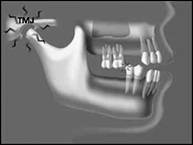

Normal Bone

After Extractions

Eventual Bone Loss
6. Facial deformity – Your smile is an important part of your facial features. Many people assume that it’s OK to lose their back teeth, “as long as it doesn’t show.” The loss of one tooth may not have such a big impact initially. However, time does take its toll. The gradual domino effect can eventually lead to loss of lip, cheek and tongue support, as well as vertical facial support, thereby severely compromising your facial aesthetics.
If you are committed to your health, then you are not willing to accept the growing problems associated with the loss of your teeth. Your first choice when considering the replacement of a missing tooth would usually be a Dental Implant. It’s a wonderfully successful option that has some distinct advantages. Fixed Bridges were previously considered the best choice and still can be effectively used to replace missing teeth. If many of your teeth are missing then consider partial dentures that restore a stable jaw joint and improve your chewing function and confidence.











Designed and Developed by Identity Namebrands Inc.
Home | Meet the Doctors | Reviews | Our Office | Promotions | Insurance & Financing | Contact Us | Office Policies © 2009 Vaughan Smiles.
MAIN NAVIGATION
© 2009 Vaughan Smiles.
